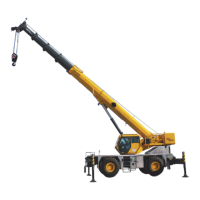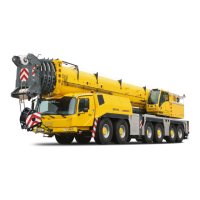Grove Published 1-20-2017, Control # 468-02 3-15
CD5515-2/YB5515-2 OPERATOR MANUAL OPERATING CONTROLS AND PROCEDURES
Axles
Warm-up Procedures for Temperatures Below -35°C
(-30°F):
1. Setup the crane on outriggers.
2. Engage the transmission (see Transmission, page 3-14)
with 4-wheel drive selected (if equipped) and allow
crane to run at idle until the temperature of the
transmission sump reaches normal operating
temperature.
NOTE: Warm-up operation of 4-wheel drive transmission
engaged in 2-wheel drive only could cause
transmission damage.
Hydraulic Oil System
Operating Limits and Warm-up Procedures:
• From 4°C to -10°C (40°F to 15°F): Crane operation
without
a load is allowed with medium engine RPM and
medium function speed (joystick position) until the fluid
reaches at least 10°C (50°F). It is then recommended
that all crane functions be cycled to remove cold fluid
from all components and cylinders of the hydraulic
system. If there is any unusual sound coming from the
crane’s hydraulic pumps or motors, stop the operation
and engine immediately and contact a Manitowoc
distributor.
• From 10°C to 4°C (50°F to 40°F): Crane operation with
a load is allowed with medium engine RPM and medium
function speed (joystick position) until the fluid reaches
at least 10°C (50°F).
• From 95°C to 10°C (200°F to 50°F): Crane operation
with a load is allowed with no restrictions.
• Above 95°C (200°F): No crane operation is allowed. Let
the crane’s hydraulic oil cool by running the engine at
idle with no functions actuated.
Cab Heater Warm-up
An Intermediate Speed Control (ISC) function of the Engine
Control Unit (ECU) is programmed to raise the idle speed to
1200 RPM when it gets a signal from the machine electrical
system. This may occur when the crane sets at idle without
operating the crane functions for extended periods of time.
Three conditions are required in order to provide this signal:
• “The engine coolant temperature is less than 71° C
(160° F).
• "The transmission is in neutral.
• “The Crane Function Switch is in the off position.
If any of these conditions change, the signal is lost, the ISC
function is turned off, and the idle returns to 800 RPM.
The brake must be applied in order to engage transmission.
Traveling with the Crane
1. Enter the operator’s cab, close the door, if equipped, and
fasten the seat belt.
CAUTION
If travel sight is restricted, do not attempt to travel with the
crane until a signalman gives a signal that the crane is
clear of obstacles in the wheel path. Remove any
obstacles from the wheel path before moving.
To help prevent accidents, use a “Slow Moving Vehicle”
Sign and a flashing strobe light (where legal) for traveling
on highways or public roads.
Reference Only
